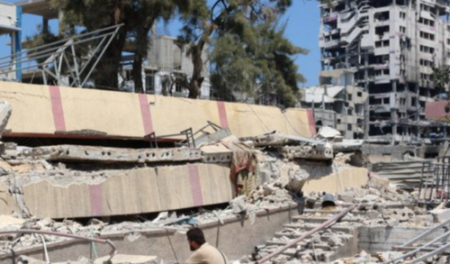By Jon Mroz: I forced myself to sit and watch a horror film last night. I’m not a fan of the genre and after being exposed to 13 months of gore and violence in Palestine via independent and mainstream media, it was a distasteful but necessary endeavor. I imagined the scenes were as real as the butchery we’ve seen in Gaza, and I conjured up an emotional investment in the fate of the characters.
The effect was mortifying and on many occasions some mechanism in my brain snapped me back to reality. I couldn’t stop myself from telling myself it wasn’t real.
A week earlier, I, like the rest of the world, watched as Shaaban al-Dalou was burned alive at Al-Aqsa Martyrs Hospital. Like all Palestinians, I feel grief, loss, panic and anger with every death.
But there was a part of my mind that didn’t want to believe what it was seeing. Somewhere between the camera lens and the computer screen, the reality of this genocide has been obfuscated.
Westerners consume media differently. Gory violence is not seen as an artistic portrayal of real events but as romanticized fantasy pulling 798 million dollars in US studio revenue in 2023. In the Middle East, the opposite is true.
Horror is not a dominant genre in the Arab world. Instead, there’s the stark reality of news. And why is this relevant? Because the flood of imagery coming from Gaza is not being absorbed as real.
Hyper-siloed, low-context and hyper-individualized Western culture was cemented by the pandemic. For years, smartphones and computer screens have increasingly become the window to the world.
Today, the truth has become drowned out in the ever-rising tide of reposted content. What we are witnessing here is yet another iteration of the cultural disconnect between West and East, North and South. How so?
It seems all too apparent to Palestinians and their Arab and western supporters that these images are real. Grief has birthed a righteous obsession to share this reality and socialize the injustice heaped upon the Palestinian people.
Liberals cannot understand why the World has turned a blind eye and social media, once thought to be the great equalizer, has become the harbinger of fascism. Journalism is in peril, not just in Gaza and the West Bank but around the globe.
We have become conditioned to “like” cute cat videos and mute or “take a break” or “report” images or people we dislike or disagree with. Entertainment and pleasure have become the measuring stick by which the apolitical grade their digital reality and we would be foolish to believe that user-generated censorship happens by pure accident.
In fact, ethics and integrity have been replaced by arbitrarily applied community standards and algorithms designed to limit, rather than expand peoples exposure to different points of view.
The privileged cannot conceive of having any kind of moral obligation as global citizens not only because they lack relatability but also because the architecture of social media that made it possible for hundreds of thousands of Gazans to bravely share this carnage with the world also made it possible for Westerners to disbelieve it.
Let’s return for a moment to the images of burning bodies or dead children. The Pavlovian response to this is to a.) turn it off, b.) associate it with violent entertainment or, c.) (and this is just a hypothesis) or to a lesser degree to accept and internalize it as fact. An inflection point can and should be created here and this can only happen by changing the way we tell the truth.
In the same way we educated the readers of yesteryear, we need to educate the consumers of digital media and elevate the understanding that these images and scenes are, in fact, real. We need to get better at captioning our work to make it impactful and persuasive and that means contending with the audience’s condition.
This is not an argument for pandering to Western imperialism, rather an observation of Western culture. To modify this behavior, we must stop assuming that Westerners can truly see the difference between fantasy and reality. It’s evident they can’t.
Social media has created the conditions for fascist propaganda to be self-generated and self-directed but by its very nature, a change in messaging could reverse this online phenomenon.
I wish it were as simple as simply telling people that what they were seeing is real, but I think the answer lies in creating rival platforms with a more egalitarian architecture for engagement, changing the way we communicate with Westerners on existing ones, and reviving and enshrining independent journalism.

